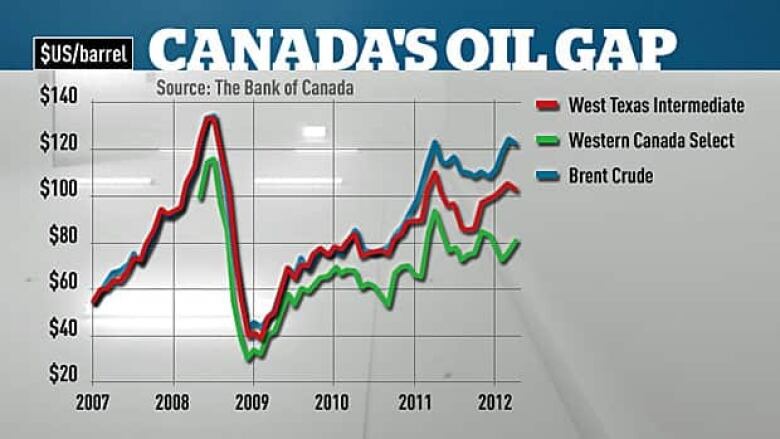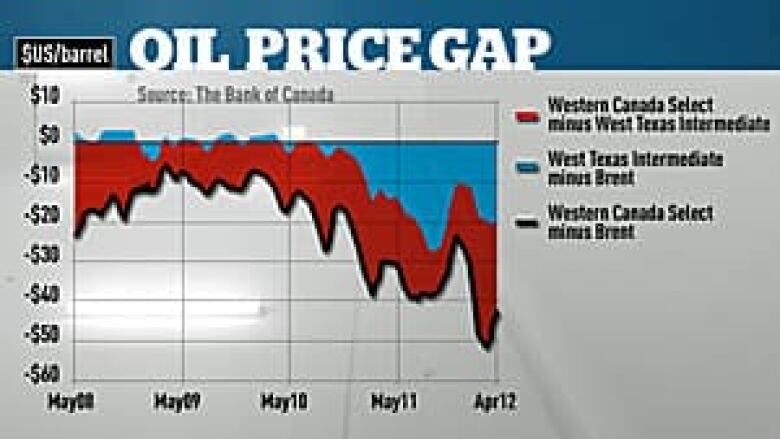Why Canada just pumps out cheap oil

Even a quick look at the price at gas pumps makes it clear that oil prices have risen this year.The European oilbenchmark,Brent crude extracted from the North Sea between Norway and Britain, has gained 15 per cent this year because of rising demand and dwindling supply due to tensions in the Middle East.
But not all oils are created equal, asprices for other blends have fallen. West Texas Intermediate, the American benchmark, has laggedbecause theres too much of the stuff right now.
Almost all North American oil at some point crosses through the refining and pipeline hub of Cushing, Okla. Theres a supply glut there at the moment and that, combined with temporary shutdowns of pipelines and refineries is pushing the spot price for WTI lower.
Supply glut
"We have more oil moving into the system than the pipeline system in North America was designed to accommodate," as Randy Ollenberger, a managing director at BMO Capital Markets puts it.
Many factors are pushing the price for North American crude lower, but the hit for Canadian oil companies specificallyis even worse. The most prevalent Canadian benchmark is called Western Canadian Select. A blend of conventional oil, bitumen and synthetics, WCS is heavier and therefore more difficult to process than some other types of oil like Brent and WTI.
Because of the added transportation and refining costs, the profit margin a refiner can earn from using WCS is less than they would get from WTI. So refiners are paying Canadian producers less per barrel as a result.
Canadaexports almost three million barrels of oil per day, and the spread has at times been in excess of $30 per barrel of late, so thats $90 million in lost revenue, every day, for the oil patch.
'We are the ones being pushed out and having to discount our oil in order to move it' BMO's Randy Ollenberger
Its one of the thingsthe Bank of Canada warned about in its latest Monetary Policy Reportthis week.Despite being awash in fossil fuels, Canadian producers arent getting as much money for their crude as suppliers elsewhere in the world do, which eats into GDP.
It's especially vexing because Canadians pay the same high prices as the rest of the world for finished petroleum products like gasoline. Add it all up and the price Canada pays for the Brent-based oil it imports is going up, and the price Canada gets for the oil we export is going downgiving our economy a hit both coming and going.
So whats the solution?
Many people say increasing pipeline capacity is the answer. "Since Canada's at the end of that pipeline, so to speak, we are the ones being pushed out and having to discount our oil in order to move it," Ollenburger said.
Backers of pipelines like Northern Gateway and Keystone XL say they're the best way totake Canadian oil more quickly and \efficiently to export markets and refineries on the Pacific coast and the Gulf of Mexico.
Recent moves toreverse the flow of oil on pipelines south of the Cushing hubwill help relieve the backlog, but over the long term, Canadas lacks a reliable system to get its crude oil to market at the best possible price.
Some say another possible solution is to build more refineries in Canada, but that, too, is problematic.
Refining industry contracting
Its a common criticism of Canadas economy that we are merely "hewers of wood and drawers of water," because we simply ship out unprocessed resources, without being more involved at every level of the supply chain to add more value to that process.
NDP leadership candidate Brian Topp made boosting Canadian refineries a plank in his failed campaign to lead the party. From the other end of the political spectrum, former Alberta Premier Peter Lougheed has also championed that idea.
Indeed, Canadas refining industry is a shadow of what it once was. In the 1970s there were about 40 refineries across the country. That figure has been whittled down to 19 today. The remaining facilities offset that decline by increasing theirindividual capacity, but the industry is far from growing as a whole. Because of fuel efficiency improvements in North America, demand for crude and distillates like gasoline, diesel and jet fuel is projected to be essentially flat moving forward.

Unlike the international market for crude, refining is dictated by local markets, and that gives refining among the slimmest profit margins of the entire energy supply chain. Over the past decade, estimates suggest that pre-tax returns in the refining industry have averaged 11 per cent per year, Conference Board economist Todd Crawford noted in a recent report.
Even in oil-rich Alberta, the oil refining business accounts for onlyabout 0.3 per cent of GDP at the moment.
A recent report by the Conference Board of Canada concluded it would cost about $7 billion to build a single new refinery. With almost 60 refineries sitting largely idle on the U.S. Gulf coast, its a tough sell to make that sort of investment in a project destined to have diminishing returns.
Never mind having to compete with some of the super-refineries in Asia. India recently built a single refinery whose output is 60 per cent of that of all of Canadas, for example.
"Our findings suggest that even if development and production of oil resources continue to grow strongly in Canada, the future economic benefits, job creation, and profits from oil refining and processing are much less assured," Crawford found in his report.
Brian Lee Crowley of the Macdonald-Laurier Institute agrees that the economics of refining are tricky. "Anything below 200,000 barrels per day isnt economical anymore," he notes.
Refineries on the U.S. Gulf coast are running well below capacity as it is (capacity is at just under 18 million barrels per day, while demand sits at under 15 million)which makes the business case for a new, Canadian refinery even more flimsy. And gulf refineries are already calibrated to process Venezuelan oil, which is chemically very similar to Canadian oil.
"Its a hugely complicated issue but at the moment, increasing Canadian refining capacity isnt the best way to get top dollar for Canadian oil," Crowley says. "Pipelines make more sense."
Beyond the Gulf coast, Crowley notes that expanded pipeline access to the B.C. coast would allow shipping to Asia, where crude is very much in demand.
"The reality is we are starting to produce more oil than we need," Ollenberger says. "So sending it over to Asia which is the fastest growing market in the world would make a lot of sense."












_(720p).jpg)


 OFFICIAL HD MUSIC VIDEO.jpg)
.jpg)



























































































